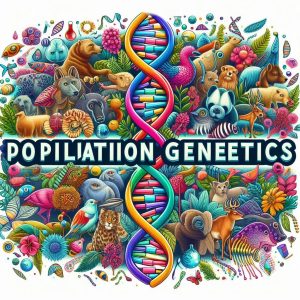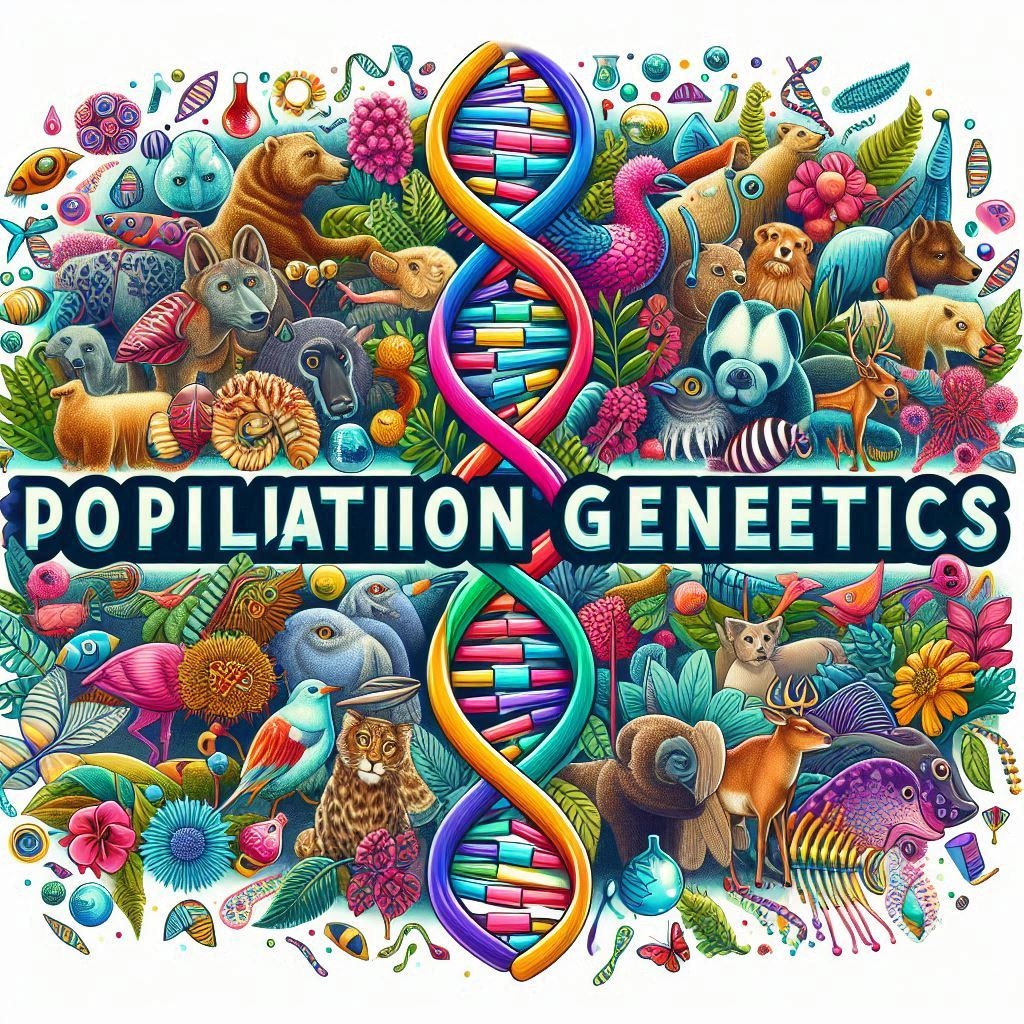Population Genetics
Population genetics is a subfield of genetics that focuses on the study of genetic variation within populations and the evolutionary processes that shape this variation. It integrates concepts from genetics, evolutionary biology, and ecology to understand how genetic factors influence population dynamics, adaptation, and evolution.
Introduction to Population Genetics
Population genetics examines how genetic variation within a population changes over time and how these changes contribute to evolutionary processes. This field provides insights into the mechanisms of evolution, genetic diversity, and the genetic structure of populations.
Key Concepts in Population Genetics
Population genetics is a field that explores the genetic composition of populations and the factors that influence genetic variation. Here are some of the key concepts in this field:
1. Genetic Variation
Genetic variation refers to the diversity in gene frequencies within a population. This variation is crucial for the process of evolution and adaptation. It can arise from mutations, genetic recombination during sexual reproduction, and gene flow between populations.
2. Allele Frequencies
Allele frequencies describe the relative abundance of different alleles of a gene in a population. They provide insights into the genetic structure and can be influenced by evolutionary forces such as natural selection, genetic drift, and migration. For more details, visit Nature Research.
3. Hardy-Weinberg Equilibrium
The Hardy-Weinberg equilibrium is a principle that predicts the allele and genotype frequencies in a population will remain constant from generation to generation in the absence of evolutionary influences. It serves as a null model to compare actual genetic data and assess the impact of evolutionary forces.
4. Genetic Drift
Genetic drift refers to the random changes in allele frequencies that occur in small populations due to chance events. Unlike natural selection, which is directed by the environment, genetic drift can lead to significant changes in allele frequencies purely by chance.
5. Gene Flow
Gene flow, also known as gene migration, is the transfer of genetic material between populations through migration and interbreeding. It can introduce new alleles into a population and affect its genetic diversity, reducing the likelihood of inbreeding and local adaptation.
6. Natural Selection
Natural selection is the process by which certain traits become more common in a population because they offer some advantage in terms of survival and reproduction. This mechanism drives adaptive evolution by favoring individuals with beneficial traits.
7. Mutation
Mutations are changes in the DNA sequence of an organism’s genome. They are a primary source of genetic variation and can have a range of effects, from neutral to beneficial or harmful. Mutations contribute to the genetic diversity necessary for evolution.
8. Inbreeding and Outbreeding
Inbreeding occurs when closely related individuals mate, which can lead to a reduction in genetic diversity and an increase in the expression of deleterious recessive traits. Conversely, outbreeding involves mating between individuals from different populations or genetic backgrounds, often enhancing genetic diversity and adaptability.
9. Effective Population Size
Effective population size (Ne) is an important concept that reflects the number of individuals in a population who contribute to the next generation’s gene pool. It is often smaller than the actual population size due to factors like unequal sex ratios and variations in reproductive success.
10. Population Structure
Population structure refers to the distribution of genetic variation within and among populations. It is influenced by factors such as gene flow, genetic drift, and selection, and can be studied through various statistical and computational methods to understand population dynamics.
Applications of Population Genetics
Population genetics is a field with wide-ranging applications that extend across various domains of biology and environmental science. Here’s an in-depth look at some of the key applications:
1. Evolutionary Studies
Population genetics plays a critical role in understanding evolutionary processes by examining how genetic variations contribute to adaptation and speciation. Researchers use population genetics to reconstruct the evolutionary history of species, identify the forces driving genetic changes, and explore the mechanisms of evolution. For example, studies on adaptive evolution provide insights into how species adapt to environmental changes.
2. Conservation Biology
In conservation biology, population genetics is essential for managing and preserving endangered species. By assessing genetic diversity, understanding population structure, and identifying genetic bottlenecks, conservationists can develop strategies to maintain genetic health and adaptability in small or fragmented populations. Techniques like genetic monitoring are used to track genetic changes and guide conservation efforts.
3. Human Health and Medicine
Population genetics is pivotal in human health research, especially in understanding genetic predispositions to diseases, identifying genetic risk factors, and developing personalized medicine. By analyzing genetic variation within populations, researchers can pinpoint genetic markers associated with diseases such as cancer, diabetes, and cardiovascular conditions. For instance, the study of genetic susceptibility helps in designing targeted therapies and preventive measures.
4. Agriculture and Crop Improvement
In agriculture, population genetics aids in the development of improved crop varieties and the management of plant breeding programs. By studying genetic variation in crops and wild relatives, scientists can identify traits that enhance yield, disease resistance, and environmental adaptability. This knowledge helps in genetic improvement and sustainable agricultural practices.
5. Forensic Science
Population genetics techniques are used in forensic science to analyze genetic material from crime scenes and identify individuals. The use of genetic fingerprinting and DNA profiling relies on understanding genetic variation within populations to establish identity, solve crimes, and exonerate innocent individuals.
6. Wildlife Management
Population genetics is applied in wildlife management to monitor genetic diversity, assess the impacts of habitat fragmentation, and guide reintroduction programs. By studying genetic variation in wildlife populations, conservationists can make informed decisions to ensure the long-term survival and health of species.
7. Evolutionary Medicine
Evolutionary medicine uses principles from population genetics to understand the evolutionary origins of diseases and health conditions. This approach helps in identifying why certain genetic variants are prevalent in human populations and how evolutionary pressures have shaped disease susceptibility.
8. Biogeography
Population genetics provides insights into the biogeographical distribution of species by studying genetic variation across different geographic regions. This information helps in understanding historical migration patterns, barriers to gene flow, and the effects of environmental changes on genetic diversity.
9. Genetic Epidemiology
In genetic epidemiology, population genetics is used to investigate the relationship between genetic factors and disease patterns within populations. This field combines genetic and epidemiological data to identify genetic risk factors for diseases and assess their distribution across different populations.
10. Evolutionary Genomics
Evolutionary genomics integrates population genetics with genomic data to explore the molecular basis of evolutionary change. By analyzing whole-genome sequences, researchers can uncover the genetic mechanisms underlying adaptation, speciation, and evolutionary processes.
Current Trends in Population Genetics
Population genetics is an ever-evolving field, reflecting advancements in technology, methodologies, and theoretical frameworks. Here are some key current trends in population genetics:
1. Integration of Genomic Data
One of the most significant trends in population genetics is the integration of comprehensive genomic data. High-throughput sequencing technologies, such as next-generation sequencing (NGS), have revolutionized the field by providing detailed insights into genetic variation across entire genomes. This approach allows for more precise and comprehensive analysis of genetic diversity, population structure, and evolutionary processes. For instance, projects like the 1000 Genomes Project and the GTEx Project are examples of large-scale genomic studies that contribute to our understanding of human genetic variation and its implications.
2. Focus on Rare Variants
There is an increasing emphasis on studying rare genetic variants and their effects on health and disease. Unlike common variants, rare variants can have substantial impacts on phenotypes and are often overlooked in traditional genetic studies. Advances in sequencing technologies and bioinformatics tools are enabling researchers to identify and characterize these rare variants more effectively. Research into rare variants has implications for understanding complex diseases and developing targeted therapies. For example, studies on rare genetic disorders provide insights into their underlying mechanisms and potential treatment options.
3. Evolutionary Genomics
Evolutionary genomics is a growing trend that combines population genetics with genomic data to explore the molecular basis of evolutionary change. This approach involves examining whole-genome sequences to understand the genetic mechanisms driving adaptation, speciation, and evolutionary trajectories. By integrating population genetic data with genomic information, researchers can gain insights into how genetic variations contribute to evolutionary processes. Notable studies in this area include research on adaptive evolution and genomic signatures of selection.
4. Application of Machine Learning and AI
Machine learning and artificial intelligence (AI) are increasingly being applied in population genetics to analyze complex datasets and make predictions. These technologies help identify patterns and relationships in genetic data that may not be apparent through traditional methods. Machine learning algorithms are used to predict disease risk, model population dynamics, and analyze genomic variation. Tools like AlphaFold showcase how AI is advancing our understanding of protein folding, which has implications for population genetics and beyond.
5. Emphasis on Environmental and Epigenetic Interactions
Current research in population genetics is increasingly focusing on the interactions between genetic and environmental factors, including epigenetics. Epigenetic modifications, such as DNA methylation and histone modifications, can influence gene expression without altering the underlying DNA sequence. Understanding how these epigenetic changes interact with genetic variation to affect phenotypes and disease susceptibility is a growing area of interest. Studies exploring gene-environment interactions and epigenetic regulation highlight the importance of considering these factors in genetic research.
6. Personalized Medicine and Genomics
Personalized medicine is a trend that leverages population genetics to tailor medical treatments and interventions to individual genetic profiles. By analyzing genetic variations, researchers can identify specific risk factors for diseases and predict individual responses to treatments. This approach aims to improve the efficacy and safety of medical interventions. The integration of genomic data into clinical practice enables the development of personalized treatment plans and preventive measures based on genetic information.
7. Global Collaborative Research
Population genetics research increasingly involves global collaborations that pool resources, data, and expertise from multiple institutions and countries. These collaborations enable large-scale studies and address questions that require diverse genetic data from different populations. International initiatives like the International HapMap Project and the Human BioMolecular Atlas Project exemplify such collaborative efforts.
8. Ethical and Social Implications
As population genetics continues to advance, addressing the ethical and social implications of genetic research is becoming increasingly important. Issues such as genetic privacy, discrimination, and the potential misuse of genetic information require careful consideration. Ongoing discussions and guidelines aim to ensure that genetic research is conducted responsibly and that individuals’ rights and privacy are protected. Resources like ethical guidelines and policy frameworks provide guidance for navigating these challenges.
9. Integration with Other Omics Data
Population genetics is increasingly integrated with other omics data, such as proteomics, metabolomics, and transcriptomics. Combining genetic data with information from these other omics fields provides a more comprehensive understanding of biological processes and phenotypic outcomes. This integrative approach helps elucidate the relationships between genetic variation, gene expression, and metabolic pathways. Examples include studies on multi-omics integration and genomic and proteomic interactions.
10. Advances in Statistical Methods
Recent advancements in statistical methods and computational tools are enhancing the analysis of population genetic data. New techniques for handling large datasets, modeling complex genetic architectures, and detecting subtle genetic effects are continually being developed. Tools such as GWAS Central and PLINK offer researchers powerful resources for analyzing genetic association data and understanding complex traits.
11. Focus on Human Population Diversity
There is a growing focus on understanding human population diversity, including the genetic variation present in underrepresented and indigenous populations. Studies aim to capture a more comprehensive view of human genetic diversity and its implications for health and disease. Initiatives like the Human Genomics Program and global genetic diversity projects work towards this goal.
12. Impact of Environmental Changes
Research is increasingly exploring how environmental changes, such as climate change and habitat destruction, affect genetic diversity and population dynamics. Understanding these impacts is crucial for predicting and mitigating the effects of environmental stressors on populations. Studies focusing on environmental genomics and adaptive responses to climate change are at the forefront of this research area.
Conclusion
Population genetics is a vital field that bridges genetics, evolutionary biology, and ecology. It provides essential insights into genetic variation, evolutionary processes, and the dynamics of populations. With ongoing advancements in technology and research methodologies, population genetics continues to expand its scope and applications, offering valuable contributions to various scientific disciplines and practical fields.
FAQs, Disclaimers, and Cautions for Population Genetics
FAQs

1. What is population genetics?
Population genetics is the study of genetic variation within populations and the forces that influence this variation, including natural selection, genetic drift, gene flow, and mutation.
2. Why is population genetics important?
Population genetics helps us understand the genetic basis of evolution, species adaptation, genetic diversity, and the dynamics of populations, which are essential for fields like conservation biology, human health, and agriculture.
3. How do scientists study population genetics?
Scientists use various methods, including genetic sequencing, allele frequency analysis, and mathematical models, to study population genetics. Techniques such as DNA profiling and genetic markers are commonly used to gather data.
4. What is Hardy-Weinberg equilibrium?
Hardy-Weinberg equilibrium is a principle stating that allele and genotype frequencies in a population will remain constant from generation to generation in the absence of evolutionary influences. It serves as a null model to detect evolutionary changes.
5. How does genetic drift affect populations?
Genetic drift refers to random changes in allele frequencies in a population, particularly in small populations. It can lead to significant genetic variations over time and can reduce genetic diversity.
6. What is the role of gene flow in population genetics?
Gene flow involves the transfer of genetic material between populations through migration and interbreeding. It can introduce new alleles, increase genetic diversity, and affect the evolutionary trajectory of populations.
7. How does natural selection influence genetic variation?
Natural selection favors individuals with advantageous traits that enhance their survival and reproduction. Over time, this process can increase the frequency of beneficial alleles and lead to adaptation to the environment.
8. What is inbreeding and how does it impact genetic health?
Inbreeding occurs when closely related individuals mate, which can increase the risk of genetic disorders and reduce genetic diversity. It often leads to inbreeding depression, where the fitness of offspring decreases.
9. How does population size affect genetic diversity?
Population size influences genetic diversity through mechanisms like genetic drift and inbreeding. Smaller populations are more susceptible to genetic drift and loss of diversity, whereas larger populations tend to have higher genetic diversity.
10. What is the significance of effective population size?
Effective population size (Ne) represents the number of individuals in a population who contribute to the gene pool of the next generation. It is often smaller than the actual population size due to factors like unequal reproductive success and sex ratio.
11. How do researchers use population genetics in conservation efforts?
Researchers use population genetics to assess genetic diversity, monitor population health, and design conservation strategies. By understanding genetic variation and structure, conservationists can make informed decisions to protect endangered species.
12. What are some common applications of population genetics in agriculture?
In agriculture, population genetics is applied to improve crop and livestock varieties by studying genetic variation and selecting traits that enhance productivity, disease resistance, and environmental adaptability.
Disclaimers and Cautions
1. Accuracy of Information
The information provided in this article is for educational purposes only. While efforts are made to ensure accuracy, the field of population genetics is continually evolving, and new research may lead to updated understanding.
2. Limitations of Genetic Studies
Genetic studies may have limitations such as sample size constraints, incomplete data, or biases that can affect the interpretation of results. It is important to consider these factors when evaluating genetic research.
3. Ethical Considerations
Population genetics research should be conducted with ethical considerations, especially when involving human subjects or endangered species. Researchers must adhere to ethical guidelines and obtain necessary permissions for their studies.
4. Misinterpretation of Genetic Data
Genetic data should be interpreted carefully, as correlations do not imply causation. Misinterpretation of genetic findings can lead to incorrect conclusions or inappropriate applications in fields such as medicine or conservation.
5. Privacy and Confidentiality
When dealing with genetic information, privacy and confidentiality must be maintained. Personal genetic data should be protected to prevent misuse and unauthorized access.
6. Impact of Genetic Research on Populations
Population genetics research can have significant impacts on populations, particularly in conservation or medical contexts. It is essential to consider the potential consequences and implications of genetic findings on individuals and communities.
7. Variability in Genetic Research Methods
Different research methods and technologies in population genetics can yield varying results. It is important to evaluate the methodologies used in studies and consider their strengths and limitations.
8. Legal and Regulatory Issues
Legal and regulatory issues may arise in genetic research, including intellectual property rights, genetic data ownership, and regulations governing the use of genetic information. Researchers should be aware of and comply with relevant legal requirements.



